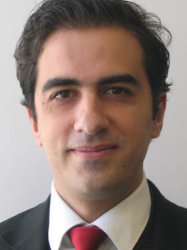Overview
Aerodynamic Control of Long-Span Bridges: post-doctoral RESEARCH
This research program supported wind tunnel tests of the stability and buffet response of flexibly-mounted bridge deck models. The bridge decks were fitted with aerodynamic control surfaces of the oscillating flap type. A combination of sensors on the deck, a digital control system and electrical actuation of the flaps were used to increase the bridge stability in the heave-torsion mode. The critical wind speed for flutter onset was evaluated from the responses at different subcritical wind speeds. Measurements were made, for a range of bridge parameters including deck geometry and smooth/turbulent incident winds, to assess the effectiveness of the system in increasing critical flutter speeds and alleviating buffeting and vortex-induced-vibration for full scale suspension and cable-stayed bridges.
Characterisation of the air flow in the human airways: post-doctoral position at Imperial College, Department of Aeronautics
An experimental investigation - Hot-wire measurements, pressure measurements and data analysis - with the Biological Flows research group led by Professor Denis J. Doorly – characterisation of the air flow in the human nostrils and airways to be used in the development of drugs that are inhaled rather than injected.
Turbulent Friction Drag Reduction using active smart surfaces (electroactive polymer and electromagnetic linear motor driven) - PhD
This was the subject investigated during the PhD programme. This is the abstract from my thesis.
Both experiments and numerical simulations have provided evidence that an initially fully developed two-dimensional boundary layer, subjected to a sudden spanwise forcing, exhibits a decrease of turbulent quantities such as the Reynolds shear stress, turbulent kinetic energy and turbulent friction drag. In past experiments and investigations, such forcing has traditionally been in the form of spanwise wall oscillations, spanwise travelling Lorentz forcing, superimposed spanwise pressure gradients and spanwise travelling waves of an in-plane flexible wall. The aim of this work was to take the idea a step further and develop an active surface which locally executes the motions described above making such a system more readily deployable.
Two surfaces were developed: both executing in-plane local oscillations with amplitude close to or larger than the mean streak spacing in a turbulent flow, but based on two different technologies, electroactive polymers in the dielectric form of actuation and electromagnetic motor forcing. The effect of these two surfaces was confined to wall-normal heights on the order of the linear sublayer of the turbulent boundary layer, and frequency and wavelength similar to those reported in literature. Extensive hot-wire measurements, some PIV measurements and direct measurement of friction drag using a bespoke drag balance were presented for the systematic variation of the relevant parameters for turbulent friction drag reduction.
Electroactive polymers (EAP) were able to undergo relatively large deflections at high frequencies. Developments in the field of EAP such as static and dynamic characterisation of the EAP membranes in use in this work, development of robust electrodes and their characterisation, in-house manufacturing of thin silicone membranes and post-processing of pre-built silicone membranes were presented. Numerical studies of the optimum pre-strain values and of the optimum electrode to passive portions width ratios were presented. Actuator development techniques including EAP membrane pre-stretch in a bespoke jig, EAP membrane pre-conditioning to go past the Mullins'' effect, electrode preparation procedure and deposition, and frame preparation were reported. Actuator characterisation results including analysis of multi-flash photographs and laser profilometer scans for in-plane and out-plane deflections at different frequencies were also presented.
Guest Lectures
Turbulent Friction Drag Reduction over Electroactive Polymer and Electromagnetically Driven Actuators, University of Surrey, Guildford, Surrey, 2012
Turbulent Friction Drag Reduction using Electroactive Polymers, Royal Aeronautical Society, London, 2011

